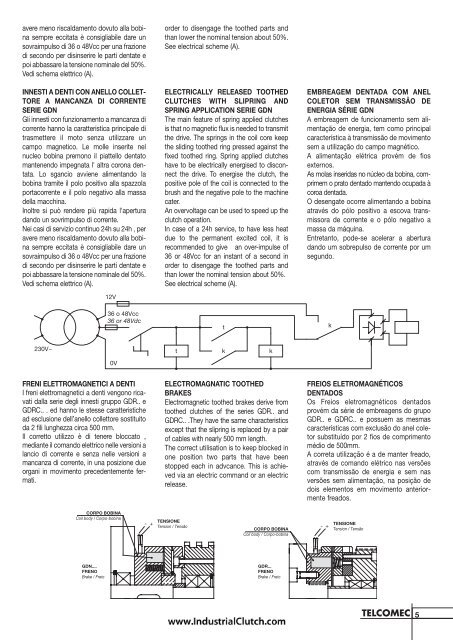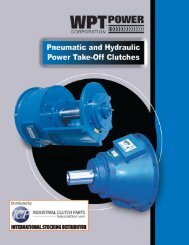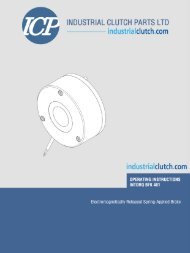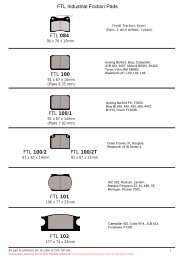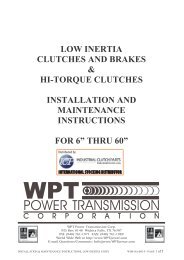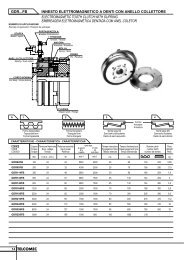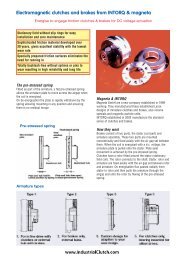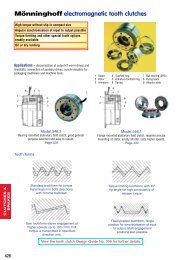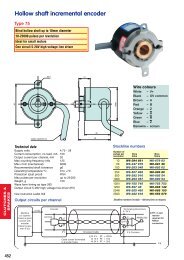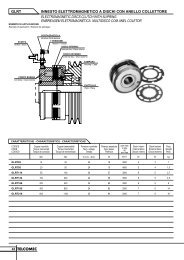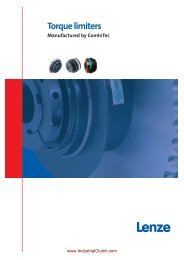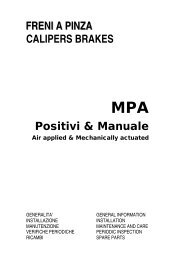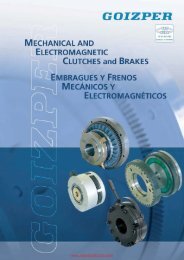Innesti e freni elettromagnetici e pneumatici a denti ed a dischi ...
Innesti e freni elettromagnetici e pneumatici a denti ed a dischi ...
Innesti e freni elettromagnetici e pneumatici a denti ed a dischi ...
Create successful ePaper yourself
Turn your PDF publications into a flip-book with our unique Google optimized e-Paper software.
avere meno riscaldamento dovuto alla bobina<br />
sempre eccitata è consigliabile dare un<br />
sovraimpulso di 36 o 48Vcc per una frazione<br />
di secondo per disinserire le parti dentate e<br />
poi abbassare la tensione nominale del 50%.<br />
V<strong>ed</strong>i schema elettrico (A).<br />
INNESTI A DENTI CON ANELLO COLLET-<br />
TORE A MANCANZA DI CORRENTE<br />
SERIE GDN<br />
Gli innesti con funzionamento a mancanza di<br />
corrente hanno la caratteristica principale di<br />
trasmettere il moto senza utilizzare un<br />
campo magnetico. Le molle inserite nel<br />
nucleo bobina premono il piattello dentato<br />
mantenendo impegnata l' altra corona dentata.<br />
Lo sgancio avviene alimentando la<br />
bobina tramite il polo positivo alla spazzola<br />
portacorrente e il polo negativo alla massa<br />
della macchina.<br />
Inoltre si può rendere più rapida l'apertura<br />
dando un sovrimpulso di corrente.<br />
Nei casi di servizio continuo 24h su 24h , per<br />
avere meno riscaldamento dovuto alla bobina<br />
sempre eccitata è consigliabile dare un<br />
sovraimpulso di 36 o 48Vcc per una frazione<br />
di secondo per disinserire le parti dentate e<br />
poi abbassare la tensione nominale del 50%.<br />
V<strong>ed</strong>i schema elettrico (A).<br />
12V<br />
order to disengage the tooth<strong>ed</strong> parts and<br />
than lower the nominal tension about 50%.<br />
See electrical scheme (A).<br />
ELECTRICALLY RELEASED TOOTHED<br />
CLUTCHES WITH SLIPRING AND<br />
SPRING APPLICATION SERIE GDN<br />
The main feature of spring appli<strong>ed</strong> clutches<br />
is that no magnetic flux is ne<strong>ed</strong><strong>ed</strong> to transmit<br />
the drive. The springs in the coil core keep<br />
the sliding tooth<strong>ed</strong> ring press<strong>ed</strong> against the<br />
fix<strong>ed</strong> tooth<strong>ed</strong> ring. Spring appli<strong>ed</strong> clutches<br />
have to be electrically energis<strong>ed</strong> to disconnect<br />
the drive. To energise the clutch, the<br />
positive pole of the coil is connect<strong>ed</strong> to the<br />
brush and the negative pole to the machine<br />
cater.<br />
An overvoltage can be us<strong>ed</strong> to spe<strong>ed</strong> up the<br />
clutch operation.<br />
In case of a 24h service, to have less heat<br />
due to the permanent excit<strong>ed</strong> coil, it is<br />
recommend<strong>ed</strong> to give an over-impulse of<br />
36 or 48Vcc for an instant of a second in<br />
order to disengage the tooth<strong>ed</strong> parts and<br />
than lower the nominal tension about 50%.<br />
See electrical scheme (A).<br />
EMBREAGEM DENTADA COM ANEL<br />
COLETOR SEM TRANSMISSÃO DE<br />
ENERGIA SÉRIE GDN<br />
A embreagem de funcionamento sem alimentação<br />
de energia, tem como principal<br />
característica à transmissão de movimento<br />
sem a utilização do campo magnético.<br />
A alimentação elétrica provém de fios<br />
externos.<br />
As molas inseridas no núcleo da bobina, comprimem<br />
o prato dentado mantendo ocupada à<br />
coroa dentada.<br />
O desengate ocorre alimentando a bobina<br />
através do pólo positivo a escova transmissora<br />
de corrente e o pólo negativo a<br />
massa da máquina.<br />
Entretanto, pode-se acelerar a abertura<br />
dando um sobrepulso de corrente por um<br />
segundo.<br />
36 o 48Vcc<br />
36 or 48Vdc<br />
t<br />
k<br />
230V~<br />
t<br />
k<br />
k<br />
0V<br />
FRENI ELETTROMAGNETICI A DENTI<br />
I <strong>freni</strong> <strong>elettromagnetici</strong> a <strong>denti</strong> vengono ricavati<br />
dalla serie degli innesti gruppo GDR.. e<br />
GDRC.. . <strong>ed</strong> hanno le stesse caratteristiche<br />
ad esclusione dell’anello collettore sostituito<br />
da 2 fili lunghezza circa 500 mm.<br />
Il corretto utilizzo è di tenere bloccato ,<br />
m<strong>ed</strong>iante il comando elettrico nelle versioni a<br />
lancio di corrente e senza nelle versioni a<br />
mancanza di corrente, in una posizione due<br />
organi in movimento prec<strong>ed</strong>entemente fermati.<br />
ELECTROMAGNATIC TOOTHED<br />
BRAKES<br />
Electromagnetic tooth<strong>ed</strong> brakes derive from<br />
tooth<strong>ed</strong> clutches of the series GDR.. and<br />
GDRC.. .They have the same characteristics<br />
except that the slipring is replac<strong>ed</strong> by a pair<br />
of cables with nearly 500 mm length.<br />
The correct utilisation is to keep block<strong>ed</strong> in<br />
one position two parts that have been<br />
stopp<strong>ed</strong> each in advcance. This is achiev<strong>ed</strong><br />
via an electric command or an electric<br />
release.<br />
FREIOS ELETROMAGNÉTICOS<br />
DENTADOS<br />
Os Freios eletromagnéticos dentados<br />
provém da série de embreagens do grupo<br />
GDR.. e GDRC.. e possuem as mesmas<br />
características com exclusão do anel coletor<br />
substituído por 2 fios de comprimento<br />
médio de 500mm.<br />
A correta utilização é a de manter freado,<br />
através de comando elétrico nas versões<br />
com transmissão de energia e sem nas<br />
versões sem alimentação, na posição de<br />
dois elementos em movimento anteriormente<br />
freados.<br />
CORPO BOBINA<br />
Coil body / Corpo-bobina<br />
- +<br />
TENSIONE<br />
Tension / Tensão - + TENSIONE<br />
CORPO BOBINA<br />
Tension / Tensão<br />
Coil body / Corpo-bobina<br />
GDN....<br />
FRENO<br />
Brake / Freio<br />
GDR...<br />
FRENO<br />
Brake / Freio<br />
TELCOMEC 5


